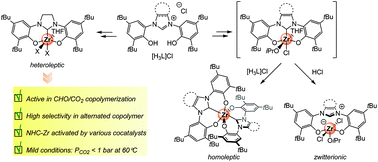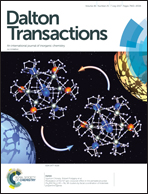Coordination behavior of bis-phenolate saturated and unsaturated N-heterocyclic carbene ligands to zirconium: reactivity and activity in the copolymerization of cyclohexene oxide with CO2†
Abstract
Tetravalent zirconium complexes supported by tridentate bis-phenolate imidazolidin-2-ylidene (L1), imidazol-2-ylidene (L2) and benzimidazol-2-ylidene (L3) NHC ligands were synthesized and evaluated as precursors for the copolymerization of cyclohexene oxide (CHO) with CO2. While the reactivity of the imidazolidinium [H3L1] chloride salt with Zr(OiPr)4(HOiPr), and subsequent ligand exchanges with either (CH3)3SiCl or LiOiPr lead to a series of heteroleptic compounds (κ3-O,C,O-L1)Zr(X)2(THF) (X = Cl, OiPr), both imidazolium [H3L2] and benzimidazolium [H3L3] chloride salts give a mixture of homoleptic (κ3-O,C,O-NHC)2Zr and zwitterionic (κ2-O,O-HL)ZrCl2(OiPr) compounds along with traces or the absence of the heteroleptic intermediate (κ3-O,C,O-NHC)Zr(Cl)(OiPr)(THF). Such dissimilar reactivity between the unsaturated and saturated NHC ligands is predominantly ascribed to the increased acidity of azolium salts along with the π-donor strength of the Ccarbene in L2 and L3–Zr moieties. The reactivity with the more acidic azolium salts (H3L2/3) and the destabilized Zr–Xtrans to NHCcarbene bond results in a significant increase in the amount of homoleptic compounds generating HCl. The released HCl reacts preferentially with the heteroleptic intermediates having non-planar NHC ligands (i.e. L2/3) promoting the formation of zwitterionic complexes. The in situ deprotonation of the isolated zwitterionic (κ2-O,O-HL3)ZrCl2(OiPr) compound by using Ag2O gives the homoleptic complex as the major component along with a bimetallic hydroxo-bridged [(κ3-O,C,O-L3)Zr(μ-OH)(OiPr)]2 compound. Of particular interest is that only the heteroleptic NHC–Zr(IV) complexes were identified to be active and highly selective towards the copolymerization of CHO with CO2 independently of the co-catalysts used (both anionic and neutral) under mild conditions (PCO2 < 1 bar, T = 60 °C), and gave atactic and completely alternating copolymers in a controlled manner (Mw/Mn ≈ 1.3–1.8). In contrast, the isolated homoleptic, zwitterionic and bimetallic zirconium species were found to be inactive under similar reaction conditions. Although the activity found for NHC–Zr(IV) complexes is nearly of the same order of magnitude as that of the NHC–Ti(IV) analogues, these results are the first examples of tetravalent zirconium complexes achieving high selectivity (99% in PCHC) in the catalyzed copolymerization of CHO with CO2.



 Please wait while we load your content...
Please wait while we load your content...